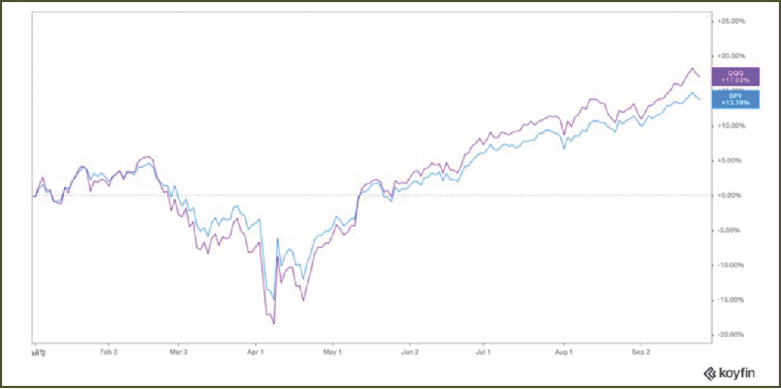Insights From ETFs: Insurance Stocks - A Defensive Play With Potential For a Recovery
2025 has been another solid year for the overall U.S. stock market. As of September, both the S&P 500 (SPY) and Nasdaq 100 (QQQ) have delivered strong total returns, providing investors with year-to-date gains of around 13% and 17%, respectively. This marks the third consecutive year of double-digit returns.

Despite these impressive numbers, not all sectors have performed well. Much of the strength this year has been driven by companies investing heavily in artificial intelligence (AI) and innovation, along with other beneficiaries of the AI theme, such as utilities and firms providing the “picks and shovels” for the AI industry.
One of the main laggards this year is the insurance industry, which has returned just 5% year-to-date—significantly underperforming both the S&P 500 and Nasdaq. Historically, insurance has been recognized as a defensive, resilient sector and a steady performer across the business cycle. While not entirely “recession-proof”, insurance companies generally hold up better during downturns than more cyclical industries. This is because individuals and businesses continue to need insurance protection even in weaker economic environments, providing stability and reliability for insurers.
Types of Insurance Companies
There are a few main categories within the broader insurance industry:
- Property and Casualty (P&C): More commonly known as home and auto insurance, these policies cover property damage and liability protection.
- Life Insurance: Provides financial support by replacing the expected income of a deceased individual.
- Health Insurance: Covers various types of healthcare expenses.
- Specialty Insurance: Focuses on niche insurance needs not covered by standard policies.
While these categories differ, the business models are broadly similar. Insurance companies generate steady cash inflows with good predictability thanks to the subscription-like nature of premiums, which are collected upfront. Claims are paid out over time, allowing insurers to invest the float in the meantime. What accounting defines as a “liability” can effectively become a valuable “asset” if underwriting is profitable.
As long as insurers manage underwriting risk effectively, the industry offers an “unbounded” growth opportunity. Surprisingly, some niche areas of insurance have consistently achieved price increases above inflation, despite the perception of insurance as a “commodity” product. With a history spanning centuries, the industry faces relatively low disruption risk from technology. Iconic compounders like Berkshire Hathaway (BRK.B) and Fairfax Financial (FFH) highlight how operational efficiency and conservative financing can create long-term shareholder value. Overall, insurance is widely viewed as an above-average industry with strong potential for long-term outperformance. Here are some ETFs that offered investors exposure to the Insurance industry.
Global X Equal Weight Canadian Insurance Index ETF (SAFE)
The Global X Equal Weight Canadian Insurance Index ETF (SAFE) provides exposure to the growth potential of Canadaís leading life and health insurers, which collectively have invested more than $960 billion in long-term assets.
Launched in November 2024, SAFE has limited performance history and currently manages a small amount of assets under management (AUM).
Its portfolio consists primarily of four major Canadian insurers:
- Great-West Lifeco (GWO) – 26.4%
- Manulife Financial (MFC) – 26.3%
- Sun Life Financial (SLF) – 24.6%
- Intact Financial (IFC) – 22.4%
- Cash – 0.3%
These well-established companies have strong records of consistent dividend growth. SAFE charges a management expense ratio (MER) of 0.16% and currently offers an annual distribution yield of 2.6%, paid monthly—appealing to income-oriented investors.
SPDR® S&P® Insurance ETF (KIE)
The SPDR® S&P® Insurance ETF (KIE), launched in 2005, tracks the S&P® Insurance Select Industry Index. With $836 million in AUM and a 0.35% MER, KIE provides diversified exposure across approximately 53 holdings, ranging from large caps to small caps. The portfolio trades at a Price/Book ratio of 1.67x.
Top holdings include:
- Brighthouse Financial – 2.1%
- Lemonade – 2.0%
- Ryan Specialty Holdings – 2.0%
- American Financial Group – 2.0%
- Genworth Financial – 2.0%
Most holdings are smaller-cap insurers that may not be widely known but generally demonstrate healthy topline growth. KIE has delivered strong performance, with 5-year and 10-year annualized returns of 17% and 12%, respectively. The fund currently offers a 1.6% distribution yield.
Invesco KBW Property & Casualty Insurance ETF (KBWP)
The Invesco KBW Property & Casualty Insurance ETF (KBWP) seeks to replicate the performance of the KBW Nasdaq Property & Casualty Index, which focuses on U.S. P&C insurers. Its holdings range from small to large caps, with the portfolio trading at 1.85x Price/Book and generating an average return on equity (ROE) of 15.2%.
KBWP has $447 million in AUM and charges a 0.35% expense ratio. The portfolio consists of 25 holdings, with no single position exceeding 9% of assets. Top positions include:
- Allstate (ALL) – 8.2%
- Travelers (TRV) – 8.1%
- Chubb (CB) – 8.1%
- Progressive (PGR) – 7.7%
- American International Group (AIG) – 7.6%
The fund offers a trailing 12-month dividend yield of 1.2%. Its portfolio includes some of the most efficient operators in the U.S. insurance industry, with decades-long track records of profitability.

